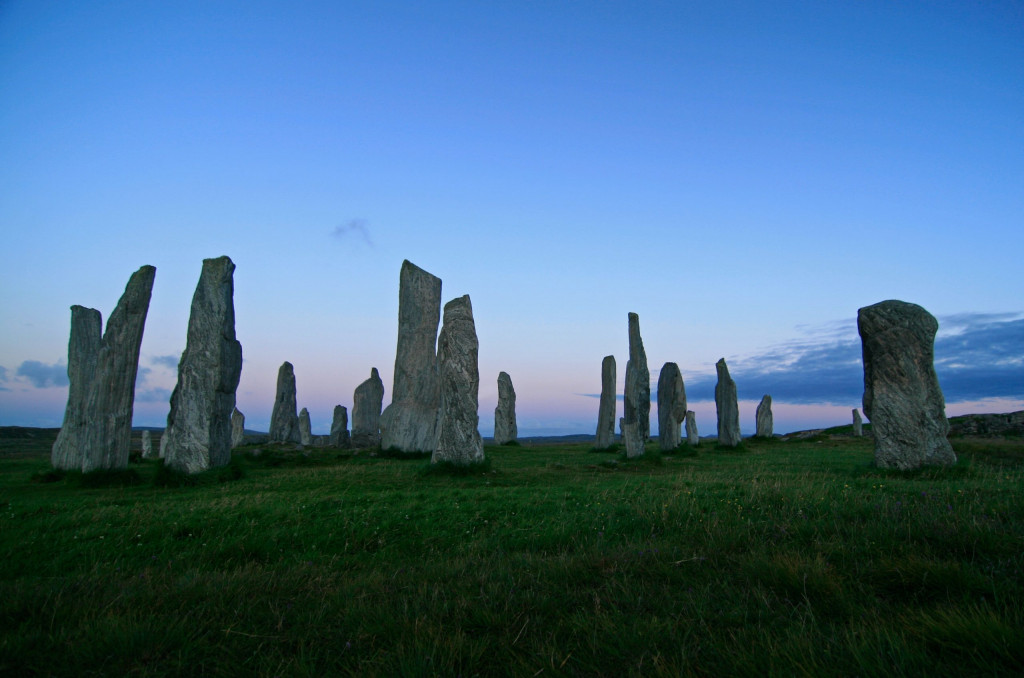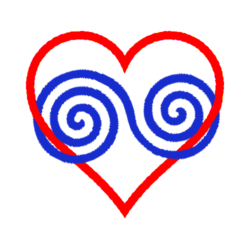The shoulders we stand upon – Part 2
The treasure trove of the Oligoamorists is teeming with heroes and monsters, idols, mythical figures and chimeras.
But the best stories are written by reality itself – or rather: it is reality that finds its expression in stories, absorbs impulses from them and finally weaves them into an incredibly colourful carpet.
I would like to dedicate this four-part series of articles to the history of Oligoamory, especially its fascinating roots and its most important value, self-awareness.

Twilight of the God(des)s
The transformations at the transition from the 19th to the 20th century also affected the spiritual life of the people, after several centuries in which mainly the Christian churches had been almost exclusively responsible for the spiritual needs of the people of Europe as well as America. As a result of ever greater social enlightenment, improving educational opportunities and an increasing freedom of choice, a desire for religious models began to emerge that offered more active self-participation, opportunities for co-creation, and a recognition of a more individualised spiritual and mental experience.
In addition to an increased attention for Hindu and Buddhist teachings, this led to a newly awakened interest in pre-Christian religions of the Mediterranean antiquity as well as in ancient pagan traditions of north-western Europe.
However, the seemingly sudden fascination concerning pagan myths of ancient times did not come out of the blue at all: Archaeologists such as Heinrich Schliemann or Egyptologists such as Sir Arthur Evans, for example, had begun to discover with new techniques and by tangible archaeological findings that numerous legends and myths of the past probably contained sometimes a verifiable, true core. The sheer possibility that legends like those of Odysseus, Cleopatra, King Arthur, the Nibelungs and Attila, even Lugh of the Long Hand or the figures of the Edda might have really happened in some way inspired countless artists* in their paintings, literature, sculpture and music; however, it also inspired numerous nationalist movements as well, which now conjured up and exploited a “rediscovered heritage” of the Celts (e.g. Druidism), Anglo-Saxons, Germans, and Slavs, etc. for their obvious political reasons.
Nevertheless, the scientific approach at the turn of the century hardly possessed any critical discourse: Most of the “specialists” in their field were usually the very first people ever to deal with a certain subject, there was almost no possibility of comparison and interdisciplinary work was still in its infancy. As a result, the “dim and distant pre-Christian past” regularly turned into a dazzling canvas for liberal ideas, egalitarian ideals and cultural counter-concepts, which often corresponded more closely to the longing and dedication of the researchers themselves as to clearly provable historical evidence. “Gaps” were often initially filled with more poetry or convenient wishful thinking; and most of the time there was no critical scientific opposition yet.
In this way, the idea of a surprisingly emancipatory, sunken ancient “ideal pagan world” began to unfold itself, for which seemingly more and more historical-literary and archaeological “evidence” was being discovered all over Europe.
The main contributors regarding this assumption were the Swiss antiquarian and anthropologist Johann Jakob Bachofen (“Das Mutterrecht”; 1861), the ethnologist and philologist James George Frazer (“The Golden Bough“, 1890), and the American folklorist and philologist Charles Godfrey Leland (“Aradia – or the Gospel of the Witches“; 1899), and last but not least – the anthropologist and Egyptologist Margaret Alice Murray. The latter finally drafted in her book “The Witch Cult in Western Europe“ (1921) a comprehensive folkloristic study that proposed a complete theory about a pan-European, pre-Christian, paganistic religion.
This religion would have been based on a polar (=opposed in relatedness) concept of divinity, which consisted of a lunar, eternal “mother goddess” (e.g. Hecate, Cybele, Isis etc.) and her companion, a solar, versatile “vegetation god” (e.g. Tamuz, Pan, Apollo etc.) – and thus was tendentiously balanced towards matriarchy and the feminine. This deep-rooted kind of worship would have been terminated during the medieval persecution of witches, when the last people who still practised this religion in small groups (so-called “circles” or “coven“) were scattered or put to death.
This scholarly treatment by Murray (and her contributors) sparked a further wave of romanticism and renewed artistic approaches; examples include e.g. Dion Fortune with her novel “The Sea Priestess” (1938) or Robert Graves and his “White Goddess” (1948).
The longing of several people for such a supposedly “unspoilt kind of original spirituality” was considerable – now only some kind of structure, a framework was needed to turn songs, myths and images of goddesses and goods into a practicable form of religion (again).
At that time, the interested consumers of the “new old myths”, who also had the leisure and the context to be able to follow those amazing developments in research and literature, often came from the educated bourgeois middle class. In this middle class it was not unusual since the mid 19th century to join “magical” or “occult” associations, such as the Freemasons or the Rosicrucians for social exchange, establishment of influence or for charitable purposes (like a kind of “private club”). These associations often still possessed a substantial continuance of ceremonies and customs, which were practised extensively, e.g. for the purpose of new admissions or on festive occasions.
Some of these ceremonies were actually quite old and were based e.g. on Neo-Platonist or hermetic rituals or they resembled traditional customs of medieval craft guilds. In this vein, charismatic persons such as Éliphas Lévi (Lodge “Rose of Perfect Silence”; 1861), Samuel Liddell MacGregor Mathers (“Hermetic Order of the Golden Dawn“; 1888) and the notorious Aleister Crowley (“Ordo Templi Orientis [OTO]”; 1912) thus became formative providers regarding an emerging magical-pagan neo-spirituality.
It only required a few more strokes of the pen to combine the various initiatives into a practicable whole…
This part was given to the Englishman Gerald Gardner, who in 1949 compiled a first “Book of Shadows“ from the ideas and conceptions outlined above, by which he then dared to establish – more or less publicly – a first actually practising pagan circle of modern times as a spiritually functioning group.
Gardner called the resulting concept “Wicca” (after the Anglo-Saxon term “Wicce”, “witch”). He incorporated the aforementioned female matriarchal accentuation as well as the coven structure (circle/convent), so that always a “high priestess” took over the leading ritual function of such a small manageable group.
The second high priestess of Gardner’s own starting group, Doreen Valiente, finally revised significantly the original version of the “Book of Shadows”, which initially comprised various sections that were not yet completely coherent, creating a printable copy for a larger audience by 1954.
Thus, Gardner’s and Valiente’s conception of Wicca, as an approach for “practicable witchcraft and paganism”, met a considerable spiritual demand, which existed in parts of non-conformist, romanticizing and esoteric circles – exactly with regard to the above-mentioned need for active self-participation,opportunities for co-creation, and a recognition of a more individualised spiritual and mental experience. The cell-like and minimal-hierarchical “coven structure” (copied from Murray), concerning 13 participants at a max, additionally accommodated a potentially individualistic culture of creativity and experience.
By the time of Gardner’s death in 1964, this cell-like organisational structure – by the formation of “offshoots” of the mother coven – had given rise to about eight further circles in Great Britain; the “international breakthrough”, however, was to come via the USA, where “Wicca” and the pagan revival found most fertile conditions.
Already in 1960 a certain Monique Wilson had been introduced (“initiated”) into Wicca by Gardner’s fourth high priestess, Lois Bourne.
In 1961 Monique had already founded her own “Coven” (circle) in Perth (Scotland), where in 1963 she consecrated the couple Rosemary and Raymond Buckland as practitioners of witchcraft (who had lived in the USA since 1962 and were in regular correspondence with Gerald Gardner).
Rosemary and Raymond subsequently founded the first “official” Wicca coven in the USA in New York; however, independently of this development, several copies of Gardner’s “Book of Shadows” had already reached the States since 1954, whereby a variety of different non-Gardnerian “Wiccan traditions” had begun to establish themselves all along.
In the USA, “Wicca” (and the modern paganism) thus met in good time the bubbling mixture of civil rights movement, social upheaval, liberation campaigns (women / gay) and “spiritual New Age” of the Kennedy/Johnson era (keywords: space program, abolition of racial segregation, Hippie culture, Vietnam War, growing consumption, health improvement, increase in women’s employment) – important factors that were ultimately to have a decisive influence on the conception of ethical non-monogamy as a whole.
But before the word “Polyamory” was actually pronounced and written for the first time, two really remarkable personalities – a high priestess and a magician of course – had to meet. About their extraordinary synergy I will tell you in Part 3.
In my conclusion today I would like to completely agree with the religious anthropologist Michael Strmiska, who in his research has dealt intensively with the “Renaissance” of different neo-pagan and witchcraft movements:
“Modern Pagans are reviving, reconstructing, and reimagining religious traditions of the past that were suppressed for a very long time, even to the point of being almost totally obliterated… Thus, with only a few possible exceptions, today’s Pagans cannot claim to be continuing religious traditions handed down in an unbroken line from ancient times to the present. They are modern people with a great reverence for the spirituality of the past, making a new religion – a modern Paganism – from the remnants of the past, which they interpret, adapt, and modify according to modern ways of thinking.”
[…]
“The rise of modern Paganism is both a result and a measure of increased religious liberty and rising tolerance for religious diversity in modern societies, a liberty and tolerance made possible by the curbing of the sometimes oppressive power wielded by Christian authorities to compel obedience and participation in centuries past. To say it another way, modern Paganism is one of the happy stepchildren of modern multiculturalism and social pluralism.” [see also Part 4]
Sources:
Raven Grimassi, „The Wiccan Mysteries: Ancient Origins and Teachings“, Llewellyn 1997
Ronald Hutton, „The Triumph of the Moon – A History of Modern Pagan Witchcraft“, Oxford-Press 1999
Philip Heselton, „Wiccan Roots: Gerald Gardner and the Modern Witchcraft Revival“, Capall Bann 2000
Michael F. Strmiska; “Modern Paganism in World Cultures: Comparative Perspectives”; Santa Barbara, Dencer, and Oxford (2005)
Thanks to Simon Hattinga Verschure on Unsplash for the photo of the Callanish Stones, Isle of Lewis (Outer Hebrides).

